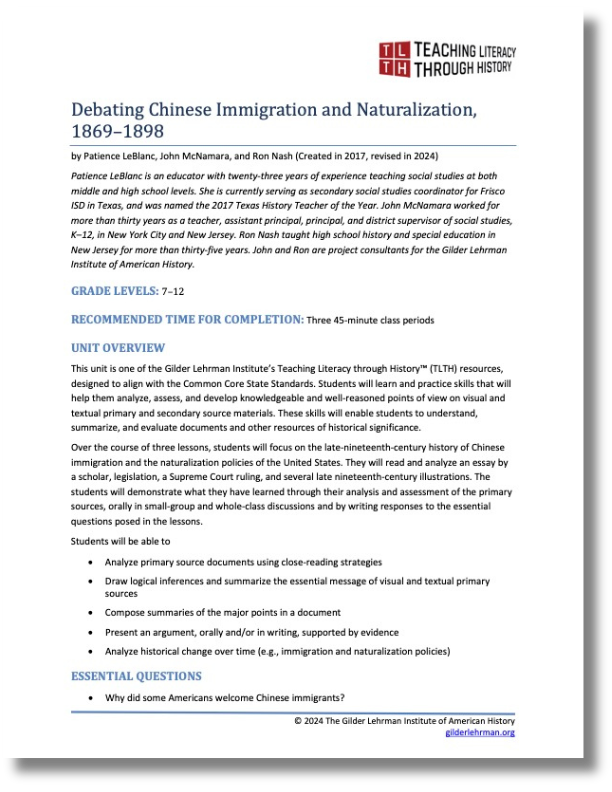Lesson by Patience LeBlanc, John McNamara, and Ron Nash
Essay by Natalia Molina, University of Southern California
Grade Level: 7–12
Number of Class Periods: 3
Primary Era: The Rise of Industrial America, 1877–1900

Over the course of three lessons, students will focus on the late-nineteenth-century history of Chinese immigration and the immigration and naturalization policies of the United States. Students will read and analyze legislation and a Supreme Court decision, and examine illustrations published in the late nineteenth century. They will demonstrate what they have learned through their analysis and assessment of the primary sources, orally in small-group and whole-class discussions and by writing responses to the essential questions posed in the lessons.
Lesson Plan Authors: Patience LeBlanc, John McNamara, and Ron Nash
Historical Background Essay by: Natalia Molina, University of Southern California
CCSS.ELA-LITERACY.RH.6-8.7: Integrate visual information (e.g., in charts, graphs, photographs, videos,or maps) with other information in print and digital texts.
CCSS.ELA-LITERACY.RH.6-8.8: Distinguish among fact, opinion, and reasoned judgment in a text.
CCSS.ELA-LITERACY.RH.9-10.2: Determine the central ideas or information of a primary or secondary source; provide an accurate summary of how key events or ideas develop over the course of the text.
CCSS.ELA-LITERACY.RH.9-10.9: Compare and contrast treatments of the same topic in several primary and secondary sources.
CCSS.ELA-LITERACY.RH.11-12.1: Cite specific textual evidence to support analysis of primary and secondary sources, connecting insights gained from specific details to an understanding of the text as a whole.
CCSS.ELA-LITERACY.RH.11-12.7: Integrate and evaluate multiple sources of information presented in diverse formats and media (e.g., visually, quantitatively, as well as in words) in order to address a question or solve a problem.
Why did some Americans welcome Chinese immigrants?
Why did some Americans oppose immigration from China?
What government policies regulated immigration from China?
How did Chinese people in America respond to discrimination?
How did Chinese Americans obtain citizenship in the nineteenth century?
Joseph Becker, “Across the Continent: The Snow Sheds on the Central Pacific Railroad in the Sierra Nevada Mountains,” Frank Leslie’s Illustrated Newspaper, February 6, 1870, p. 346.
The Chinese Exclusion Act of 1882, An Act to Execute Certain Treaty Stipulations Relating to Chinese, US Statutes at Large 22 (1881)
Thomas Nast, “Uncle Sam’s Thanksgiving Dinner,” Harper’s Weekly, November 20, 1869.
Joseph Ferdinand Keppler, “The Chinese Invasion,” Puck, March 17, 1880.
“The Chinese Must Go,” advertisement for “The Magic Washer,” George Dee, Dixon, Illinois, 1886
The Page Act of 1875, An Act Supplementary to the Acts in Relation to Immigration, US Statutes-at-Large 18 (1875): 477–478
Justice Horace Gray’s Majority Opinion in United States v. Wong Kim Ark, 1898, 169 US 649 (1898)